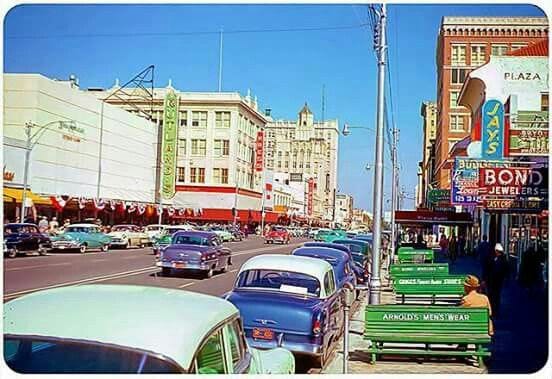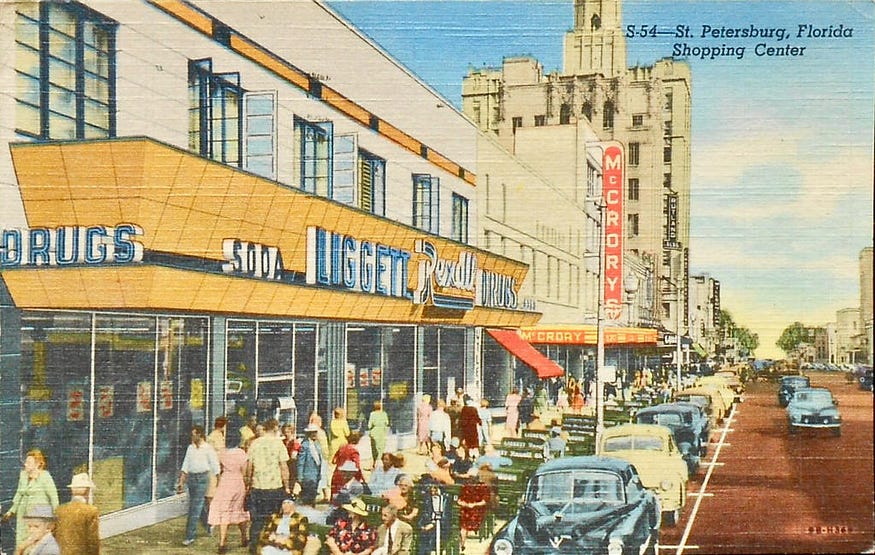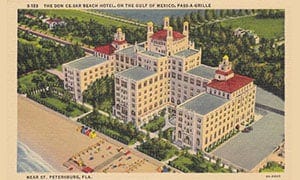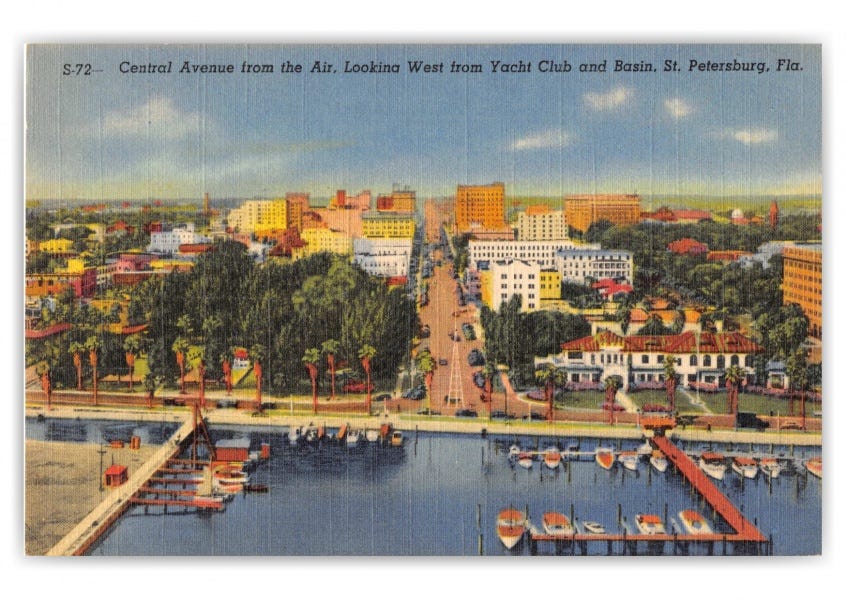
Nestled along the sun-kissed shores of Florida’s Gulf Coast, St. Petersburg stands as a living testament of FL & American history. Founded in 1888 by John C. Williams and Peter Demens, who envisioned a thriving community amidst the pristine beauty of the peninsula, St. Pete’s journey began with a humble beginning. From its incorporation in 1892 with fewer than 300 residents, to its rise as a major Gulf Coast resort destination, St. Petersburg has witnessed many historic events and has hosted its fair share of Iconic Landmarks and Events. Featuring a landscape adorned with ancient Indian mounds, opulent glamourous resorts, and architectural marvels, St. Pete holds a unique place in the annals of Florida’s past.

Whether strolling through the cobblestone streets of its historic neighborhoods or immersing oneself in the cultural tapestry of its museums and galleries, every corner of St. Petersburg tells a tale of resilience, innovation, and boundless beauty. As we embark on a journey through its hallowed streets, let us celebrate the legacy of St. Pete and honor the pioneers who paved the way for generations to come.

1. Roser Park Neighborhood
Step into the past with a visit to the Roser Park Neighborhood, a charming enclave that boasts a tapestry of architectural styles dating back to the late 19th century. Designed by acclaimed architect C. Perry Snell, this historic district is a testament to the city’s early years. Named after Charles Roser, the inventor of the Fig Newton, the neighborhood not only showcases stunning Mediterranean Revival, Craftsman, and Colonial Revival-style homes but also played a pivotal role in the civil rights movement of the 1960s. Residents of Roser Park actively participated in protests and sit-ins, leaving an indelible mark on the city’s history.

2. Museum of Modern Art and History
Dive into the vibrant art scene of the 1960s at the Museum of Modern Art and History, where creativity knows no bounds. Designed by architect John Volk, this architectural gem houses a diverse collection of exhibits featuring works by iconic artists such as Andy Warhol, Jackson Pollock, and Salvador Dali. The museum’s sleek lines and minimalist design pay homage to the modernist aesthetics of the era. Did you know? The museum’s permanent collection includes Warhol’s revolutionary “Campbell’s Soup Cans” and Dali’s mesmerizing “The Persistence of Memory,” offering visitors a glimpse into the avant-garde spirit of the 60s.
3. The Don CeSar
Indulge in old-world charm at The Don CeSar, a legendary beachfront resort that has graced the shores of St. Pete since the 1920s. Known as the “Pink Palace,” this iconic hotel was designed by architect Henry H. Toombs and has hosted an array of luminaries, including F. Scott Fitzgerald, Al Capone, and Franklin D. Roosevelt. During World War II, the Don CeSar served as a sanctuary for wounded soldiers, earning it the moniker “The Pink Lady of St. Pete.” Today, visitors can bask in the hotel’s historic ambiance while savoring modern luxuries such as spa treatments, gourmet dining, and sunset strolls along the pristine beaches.

4. Weedon Island
Venture into the heart of nature at Weedon Island, a sanctuary of serenity nestled along the shores of Tampa Bay. This pristine wilderness area, inhabited by Native American tribes for over 5,000 years, offers a glimpse into Florida’s ancient past. Archaeological excavations have unearthed artifacts dating back to the Weedon Island culture, while interpretive trails lead visitors through mangrove forests and ancient shell mounds. Keep an eye out for wildlife, including dolphins, manatees, and migratory birds, as you kayak through the tranquil waters of the island.
A Movie called “Playthings of Desire” Was filmed here. See poster below.


5. Pinellas Point Indian Mound
Unlock the mysteries of the past at the Pinellas Point Indian Mound, an ancient archaeological site shrouded in legend. Constructed by the Tocobaga tribe over 1,000 years ago, this monumental mound serves as a testament to Florida’s indigenous heritage. According to local folklore, the mound is the traditional site where a Tocobaga princess saved the life of Juan Ortiz, a sailor captured by Spanish explorers. Some scholars believe this tale inspired the later story of John Smith and Pocahontas, adding to the mound’s mystique. Today, visitors can explore the site’s significance through interactive exhibits and guided tours.



6. The Downtown Post Office:
Experience a piece of history at the Downtown Post Office, a striking Art Deco landmark that has been serving the community since the 1930s. Designed by architect Howard Lovewell Cheney, this historic building features elegant marble interiors, intricate bronze fixtures, and stunning murals depicting scenes of local history. The post office played a pivotal role in St. Petersburg’s development, serving as a hub for mail distribution and communication during the early 20th century. During World War II, the building was used as a recruitment center for the U.S. military, with thousands of local residents enlisting to serve their country. Today, the Downtown Post Office continues to operate as a full-service postal facility, while also serving as a cultural and architectural landmark in the heart of downtown.
7. The Sunken Gardens:
Escape the hustle and bustle of city life and find serenity at The Sunken Gardens, a lush oasis nestled in the heart of St. Petersburg. Originally established in the 1930s, this botanical paradise features winding paths, flamingoes, cascading waterfalls, and over 50,000 tropical plants from around the world. Discover hidden grottos, vibrant blooms, and exotic species, all carefully curated to create a feast for the eyes and soul. Designed by landscape architect George Turner Sr., the gardens were once part of a private residence owned by local businessman George Turner Jr. In 1999, the gardens were acquired by the city of St. Petersburg and transformed into a public park, ensuring that future generations could enjoy its beauty and tranquility.


8. Driftwood Neighborhood:
Experience the charm of yesteryear in the Driftwood Neighborhood, a quaint residential area that evokes the nostalgia of an era long gone. Named for its picturesque driftwood trees, which line the shores of Tampa Bay, this historic district features a mix of architectural styles, including Spanish Mediterranean, Mid-Century Modern, and Florida Ranch Style, also appropriately named Florida Cracker. The neighborhood was developed in the early 20th century by real estate developer Perry Snell, who envisioned a waterfront community that would capture the essence of Florida living. Today, the Driftwood Neighborhood is a popular destination for residents and visitors alike, with its scenic waterfront parks, historic homes, and charming boutiques. A walk here is a must for any visitors or locals.
9. Egmont Key:
Embark on an island adventure to Egmont Key, a remote paradise steeped in history and natural beauty. Located at the mouth of Tampa Bay, this uninhabited island is home to a wealth of archaeological sites, historic landmarks, and pristine beaches. Explore the ruins of Fort Dade, a 19th-century military outpost, or snorkel in the crystal-clear waters surrounding the island, where vibrant coral reefs and colorful marine life await. Egmont Key has a rich maritime history, with numerous shipwrecks and lighthouses dotting its shores. In 1974, the island was designated as a wildlife refuge and protected sanctuary, ensuring the preservation of its unique ecosystems for future generations to enjoy.
It also was a departure point for hundreds of Seminole Indians during the Trail of Tears, a brutally sad chapter in American history. Additionally, during the Civil War, it served as a crucial blockade station.
Throughout the years, the waters around St. Petersburg have seen their fair share of activity. Explorers, fishermen, and even pirates have ventured through these waters. In 1539, Hernando de Soto sailed these very waters, setting out on his famous expedition that eventually led to the discovery of the Mississippi River. Following him, other explorers and Cuban fishermen navigated these seas. Notorious pirates like Gasparilla (Jose Gaspar) also made their mark, roaming the Gulf until the U.S. Navy intervened to restore order.


10. Old Northeast Neighborhood:
Step back in time with a visit to the Old Northeast Neighborhood, a picturesque hidden gem that showcases the architectural achievements of St. Petersburg’s early 20th century. Characterized by its charming bungalows, tree-lined streets, and various homes-turned-historic landmarks, this district offers a true glimpse into the city’s past. Designed by prominent architects such as Richard Kiehnel and Dwight James Baum, the neighborhood features a mix of architectural styles, including Mediterranean Revival, Tudor Revival, and Colonial Revival. Many of the homes in the Old Northeast are listed on the National Register of Historic Places, preserving their architectural integrity and cultural significance for future generations.
11. Mahaffey Theater:
Experience the magic of live performance at the Mahaffey Theater, a cultural hub that has been entertaining audiences since the 1960s. Located in downtown St. Petersburg, this state-of-the-art venue hosts a diverse array of concerts, Broadway shows, and dance performances throughout the year. Designed by architect William B. Harvard, the theater’s sleek lines and modernist aesthetic reflect the architectural trends of the mid-20th century. Over the years, the Mahaffey Theater has welcomed legendary performers such as Frank Sinatra, Ella Fitzgerald, and Ray Charles, cementing its reputation as one of Florida’s premier entertainment venues.

12. The Dali Museum:
Although this is a new building, the Dali museum is revered nationally for its collection, design, and campus. Its time to immerse yourself in the surreal world of Salvador Dali at The Dali Museum, home to the largest collection of the artist’s works outside of Spain. From mind-bending paintings to whimsical sculptures, every corner of this architectural marvel is a testament to Dali’s genius. Designed by architect Yann Weymouth, the museum’s distinctive glass atrium and spiral staircase create a dramatic backdrop for Dali’s iconic masterpieces. The museum’s permanent collection includes several of Dali’s most famous works, including “The Disintegration of the Persistence of Memory” and “The Hallucinogenic Toreador,” as well as rotating exhibits that showcase the artist’s versatility and innovation.
13. The St. Pete Natural History Museum:
Discover the wonders of the natural world at The St. Pete Natural History Museum, where interactive exhibits and immersive displays bring science to life for visitors of all ages. From dinosaur fossils to live animal encounters, to a Tampa Bay Mummy, the museum offers a fascinating glimpse into the diverse ecosystems of Florida and beyond. Designed by architect George F. Reed, the museum’s building is a prime example of mid-century modern architecture, with its sleek lines and minimalist design reflecting the optimism and innovation of the 1960s. The museum’s galleries are filled with hands-on activities and educational exhibits that explore topics such as geology, ecology, and paleontology, making it a popular destination for families and school groups.
14. Ted Peters Famous Smoked Fish:
Savor a taste of tradition at Ted Peters Famous Smoked Fish, a beloved local institution that has been serving up mouthwatering seafood since the 1950s. Located on the shores of Boca Ciega Bay, this iconic eatery is renowned for its hickory-smoked fish, including mullet, salmon, and mackerel. Founded by Ted Peters Sr., the restaurant has remained in the Peters family for three generations, with each successive owner preserving its time-honored recipes and commitment to quality. Over the years, Ted Peters has become a cherished gathering place for locals and visitors alike, who come to enjoy its laid-back atmosphere, friendly service, and delicious smoked specialties.
15. Fort De Soto: Delve into military history at Fort De Soto, a historic fortress that has guarded the entrance to Tampa Bay for over a century. Built in the late 19th century during the Spanish-American War, the fort served as a key strategic outpost for the U.S. Army and Navy, protecting the bay from enemy attacks. Today, visitors can explore the fort’s well-preserved ruins and learn about its role in American military history through interpretive exhibits and guided tours. The surrounding park offers a variety of recreational activities, including hiking, biking, and picnicking, as well as pristine beaches and wildlife viewing opportunities.
St Pete is absolutely stunning. I love living here. I love taking walks downtown and reading all the historic plaques. Here is a great downtown walking guide to help you plan your day to St Pete: https://floridahistory.org/ST-PETERSBURG.htm



I hope you, dear reader, are able to learn some new exciting information about the area you live in. Please take what you’ve read and build a “Vintage Day!” Top it off with some local vintage shopping — not only are there plenty of thrift stores, theres anqitue and vintage resell shops around as well.
IM Vintage, our store, features Mid Century Modern furniture and home goods. We source the highest quality, and we try not to change a single thing about the pieces of history we find.
Full Court Classics sells vintage streetwear and sneakers.
CASA is a local thrift that goes to a great cause — local abuse survivors.
Hopefully we see you soon!

